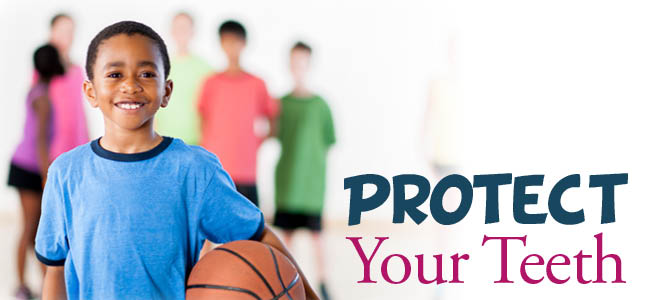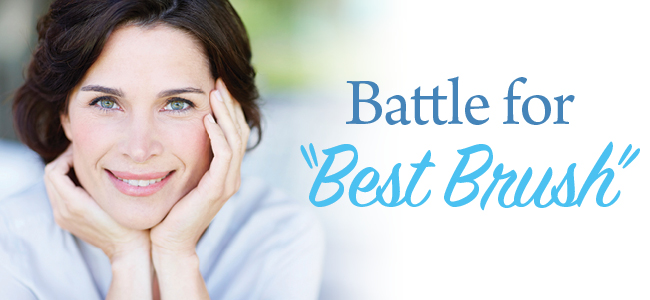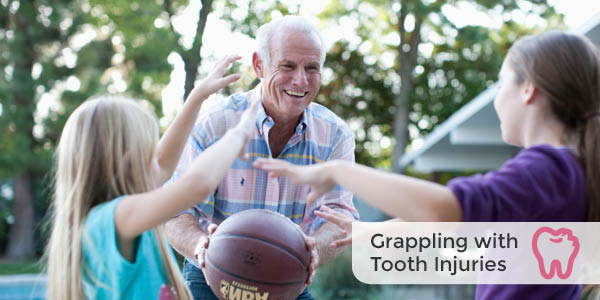By admin
02 Mar, 2016
Dental Emergency, Dental Health, Dental Tips, General Dentistry, General Health, Lifestyle, Preventive Dental Care
broken tooth, dental emergency, dental injury, dental trauma, knocked out teeth, mouthguards

The madness of March is right around the corner, and 68 NCAA Division I basketball teams will go head to head over the course of three weeks to determine the national champion — and you know what that means: excitement, upsets, and kids and adults alike heading out to have fun on the courts themselves.
Getting involved in any athletic activity is a great way to stay fit and healthy. Whether you are 8 or 58, sports offer an excellent form of active entertainment and exercise, but they also pose a threat to your oral health.
What the Stats Say
According to a new study*, playing sports comes with the heightened risk of dental and orofacial injuries:
- Each year more than 5 million teeth are knocked out of their sockets as a result of trauma.
- Basketball, football, hockey, martial arts, and boxing have the highest tooth-injury risk.
- Soft-tissue lacerations are the most common mouth and face injuries that occur during sports activities.
- Dental trauma can include tooth fracture, tooth loss, or injury resulting in a loose tooth.
Protect Your Teeth with a Mouthguard
The added risk to your dental health doesn’t mean you or your loved ones should shy away from playing sports. There are protective measures you can take to dramatically reduce the chances of damaging your teeth. The American Academy of Pediatric Dentistry (AAPD) recommends a mouthguard for all children and youth participating in any organized sports activities, including the following:
- Acrobatics
- Basketball
- Boxing
- Extreme
- Rugby
- Skateboarding
- Soccer
This recommendation is suitable for adults as well. In fact, according to the ADA, sports mouthguards have been shown to reduce the risk of sports-related dental injuries. Statistics show* that the overall rate of an orofacial injury is 1.6 to 1.9 times higher when a mouthguard is not worn. And while basketball and baseball are two sports in which dental and facial trauma are relatively common, participants rarely wear protection. Fortunately, famous athletes like Stephen Curry and LeBron James are great examples of athletes who are rocking mouthguards and killing it on the court.
So before you test your skills on the court, consider the example they have set. Having a dental provider fit you with a mouthguard that is resilient, comfortable, and durable could mean the difference between keeping or losing your teeth in a sports-related incident.
To find out more about mouthguards, call your Lancaster dental office at (661) 952-7865 to talk to a provider today!
*Young, E., Macias, R., Stephens, L. Common Dental Injury Management in Athletes. Sports Health: A Multidisciplinary Approach. 2013;20(10):1-6.
More
By admin
17 Feb, 2016
Dental Tips, General Dentistry, General Health, Lifestyle
chipped tooth, cracked tooth, dental emergency, dental injury, dental mouthguard, dental tips, fractured tooth, sport mouthguards, tooth loss
This time of year the weather shifts to longer, warmer, and brighter days allowing families who have been in hibernating to begin enjoying some of their favorite outdoor activities again. From hiking and biking to actively engaging in sports like baseball and soccer, the fun factor is high and so is the opportunity for dental disasters.
There are many ways to protect you and your children’s teeth while enjoying the active side of life. Mouth guards and helmets are a must, but even with the best precautions in place, that unexpected spill from a bike or a missed footstep on the trail can quickly lead to a dental emergency. While you can’t predict when a dental emergency will happen the following tips will help you navigate every thing from a broken tooth to damaged orthodontics so you can get back to enjoying your springtime fun in no time at all.
- Knocked-Out Tooth: Rinse the tooth carefully, making sure not to wash away any remaining tissue. Attempt to place the tooth back in its socket carefully. If this is not possible, place it in a container of milk, or water with a pinch of table salt. Call your emergency dentist immediately. Your tooth has the best chance of being saved if you are seen within an hour of having it knocked out.
- Chipped, Cracked, and Broken Teeth: Gather and rinse all broken pieces of the tooth. Rinse your mouth with warm water and apply gauze if there is bleeding. Use a cold compress to relieve pain and swelling in the injured area, and contact your emergency dentist to be seen immediately.
- Fractured Tooth: Dentists can easily fix fractures with a composite restoration. A dentist should be seen within a couple days of the injury.
- Partially Dislodged Tooth: When a tooth gets pushed out of its proper position, it is important to manage the pain and get into your emergency dentist immediately. Apply a cold compress to the area and take a pain reliever such as acetaminophen or ibuprofen as needed.
- Lost or Broken Crown: Save your crown and set up an appointment with your emergency dentist right away. If possible, use over-the-counter dental cement to reattach the crown. If there is any pain, take an over-the-counter pain reliever such as ibuprofen or acetaminophen. Clove oil can also be used to soothe sensitive areas.
- Broken Braces: Orthodontic wax can be used to cover or temporarily reattach loose brackets and broken wires. If a broken wire is poking out and into your cheek or tongue, use the eraser end of a pencil to move it into a comfortable position, then cover it with wax, gauze, or cotton. See your orthodontist to have your braces repaired.
- Soft-Tissue Injuries: Tears, punctures, and lacerations to the soft tissues of the cheek, lips, or tongue should be cleaned and packed with gauze. A trip to the emergency room is necessary if stitches are needed.
If you or your children are considering joining a full-contact sport, preparing for a dental emergency is key to preventing tooth loss.
The following are a couple of items and information to have on hand:
- Dentist’s phone number and email address
- Small, portable container for dental emergency kit
- Saline solution
- Tissue
- Gauze
- Orthodontic wax
- Dental cement
- Compress
- Ibuprofen and/or acetaminophen
Finally, one of the most important steps you can take toward protecting your smile in any sports-related activities is talking to your dentist about a mouthguard. According to the American Dental Association, sport mouthguards have been shown to reduce the risk of sport-related dental injuries. Having a dental provider fit you with one that is resilient, comfortable, and durable could mean the difference between keeping or losing your teeth in a sports-related incident.
To find out more about mouthgaurds and protecting your teeth, call your Lancaster dentist today at (661) 952-7865.
More

The 88th Academy Awards will be held on February 28. Viewers everywhere will tune in to see if their favorite actors, actresses, directors, and other cinematic professionals will win their Oscars. But when it comes to watching the Academy Awards, finding out who gets the big wins is only part of the fun. Watching who comes with who and seeing who wears what is a large part of what makes the Oscars worth throwing a party or friendly gathering for.
Year after year, viewers and reviewers spend weeks after the awards recalling which dresses were worn, commenting on the hairstyles that are sure to start trends, and wondering how the stars managed to get those Hollywood smiles. While most of us will never be able to afford that one-of-a-kind Versace gown, the good news is that a beautiful, white Hollywood smile is just a call away.
Smile Design
Smile Design offers you the opportunity to achieve a smile that is as bright and beautiful as the stars’ on Oscar night. Smile Design offers a suite of services to choose from that, when added to a strategically crafted dental plan, result in a confidence-boosting aesthetic.
Smile Design services include:
Dental implants: Implants offer a permanent, long-term solution for missing teeth. Not only do they look and feel like natural teeth, they also maintain your facial structure and integrity. A dental implant consists of a small, screw-shaped, titanium post that replaces the root of a missing tooth and is covered by a porcelain tooth-like crown that will give you back your natural smile. Depending on the number of missing teeth, there are options for single-tooth and multitooth replacement.
Crowns: Over time teeth can become weak or severely worn down, leading to decay, cracking, and breaking. Porcelain crowns are the perfect restoration for cracked, chipped, or broken teeth. These natural-looking covers make imperfections in teeth entirely unnoticeable. When crafted carefully and with your individual needs in mind, a permanent crown can restore your confidence, comfort, and overall quality of life.
Teeth whitening: As you age, your teeth are exposed to foods and drinks that stain them. Though your teeth may be perfectly healthy, they can appear damaged and make you look older. Fortunately, if you have deep stains or want to achieve a brighter smile quickly, there are teeth-whitening options that can help you acquire a beautiful, youthful-looking, bright smile. Both at-home and in-office treatment options are available and use the most effective teeth-whitening systems available today. All treatment options are simple and noninvasive.
Porcelain veneers: Sometimes teeth are damaged or discolored in a way that can’t be corrected with crowns or whiting treatments. When this happens, veneers offer a beautiful solution. These ultra-thin, tooth-colored coverings are custom made and are fit to the front surface of your teeth, changing the appearance to the size and shape you desire. Veneers are perfect for fixing discolored and chipped teeth.
Straightening: Straightening your smile no longer requires years of wearing metal wires on your teeth. There are a variety of “invisible” straightening options, such as Six Month Smiles® and Invisalign®, which allow you to have a straighter, more aesthetically pleasing smile in just a matter of months.
If you find yourself feeling uncomfortable with or embarrassed about your smile, or if you simply wish it was just a bit brighter or whiter, Douglas B. Weber, DDS, can help you with our cosmetic and Smile Design services. Call us at (661) 952-7865 to set up your personal consultation — and look forward to feeling red-carpet ready in no time at all.
More
By admin
08 Feb, 2016
Dental Health, Dental Tips, General Dentistry, Lifestyle
children's dentistry, dental health, gifts, healthy smile, pediatric dentistry, tooth-friendly treats, toothbrush, valentine's day

Nothing Is Sweeter Than a Healthy Smile
Valentine’s Day is a holiday that can leave many parents feeling conflicted. Anything that gives you an excuse to spoil your kiddos with gifts and tell them how much you love them is a welcome retreat from the daily grind of handing out chores and pushing through homework. One daily parenting task that commonly elicits dread is convincing your children to brush their teeth. Every parent knows how important their children’s oral health is, and instilling solid early oral hygiene practices so that your kids can enjoy a lifetime of healthy smiles is even more important. Thus the downside of Valentine’s Day: all the sugary treats.
Valentine’s Day is almost as notorious a threat to your kids’ teeth as Halloween. They inevitably come home from their classroom celebrations with paper bags full of chocolate and handfuls of candies with messages of love written on them. While these lovely confections please your kids, they are anxiety inducing when you catch yourself considering the damage being done to your children’s tiny pearly whites.
That’s not to mention the difficulty you face when trying to figure out gifts to give them and Valentines they can give to their friends and classmates that won’t cause cavities. While you can’t control what they will be bringing home, you can skip on contributing to acts of love that promote decay. Below we have put together four DIY, tooth-healthy Valentine’s Day gift ideas that show love while also producing happy, healthy smiles.
“You Make Me Smile” Toothbrush Valentine (Adapted from Time 2 Save Time 2 Give): This Valentine is simple to make and sends a sweet message while promoting good oral hygiene habits. You will need child-friendly toothbrushes, ribbon, colored paper, and a marker. Simply cut small hearts out of the paper and write a Valentine’s Day message like “You Make Me Smile” on each one. Attach ribbon to the back of the heart with tape and tie it to a toothbrush (still in package). You children’s classmates won’t be the only ones grinning! You can bet their parents will be feeling the love too.
Paper Airplane Valentine Free Printable (From NoBiggie.net): NoBiggie.net offers a free customizable, printable airplane Valentine that is perfect for the future pilots in your family. It’s quick and easy to make with corresponding numbers to help guide your way, and there’s even a video tutorial to walk you through creating the airplanes, making this a great last-minute go-to if you’ve been procrastinating.
I’m Nuts About You Treat Bag Printable (From Design Dining Diapers): If your children just have to hand out yummy treats, bags of peanuts are perfect. This tooth-friendly treat is low in sugar and high in protein, and if you go to the Design Dining Diapers site and follow the instructions, you can download a printable tag that says “I’m Nuts About You” and use it to fasten shut your baggie full of peanuts, leaving your children with a fun, yummy Valentine to hand out to friends.
Lunchtime Love: Show your children how much you love them with a little lunchtime love. You can give your children yummy hearts that aren’t made out of chocolate. Most kitchen-supply stores carry stainless-steel sandwich cutters in a variety of shapes and sizes. Use heart-shaped cutters to turn a turkey sandwich in a friendly reminder that you care. Smaller cutters can be used for meat and cheese slices or to turn slices of melon into a juicy, red dessert.
Valentine’s Day doesn’t have to lead to decay; there are plenty of candy-less ways to celebrate love. If your children come home with bags full of sugary goodies, make sure they brush their teeth after every treat — and then call us to book an appointment for a cleaning.
Happy Valentine’s Day from all of the staff at Douglas B. Weber, DDS!
More

Once every three or four months, you inevitably find yourself standing in the oral hygiene aisle at the grocery store scanning rows and rows of an endless variety of toothbrushes. They come in all shapes, sizes, and colors — and some of them even come with small motors. But how do you know which one is the best for you or your children?
The Basics
There are some basics you should look for when purchasing a new brush:
- The handle of the toothbrush should be a length and shape that best allows you to hold and maneuver it as you brush.
- The head of the toothbrush should be able to easily access all of the surfaces of your teeth. A half inch wide and one inch tall works best for most adults.
- Toothbrushes come with bristles that are categorized as hard, medium, and soft. Soft is preferable for most people; medium- and hard-bristled brushes can cause damage to tooth enamel.
- Choose a brush with American Dental Association-approved nylon bristles.
Manual or Electric
Electric toothbrushes have become increasingly popular over the last several years. They come in all shapes and sizes, and they are suited for both children and adults. But are they more effective than manually brushing your teeth with a traditional brush? The American Dental Association (ADA) has addressed this topic in multiple news releases, saying that manual brushes can indeed be as effective as electric. People using manual brushes who have excellent oral hygiene practices can prevent tooth decay as well as those who use electric.
Electric toothbrushes can be very helpful for people who have difficulty adequately brushing. Individuals who suffer from a disability or arthritis, as well as children just learning to brush, stand to benefit from using a suitable electric brush.
Manual vs. Electric
Both manual and electric toothbrushes have their benefits and their drawbacks. This is how they stack up next to each other.
Benefits of the Manual Toothbrush
- Teeth can be adequately cleaned after only two minutes of brushing.
- Toothbrushes come in a large variety of sizes, shapes, and colors, so you can find the one that works perfectly for you and each of your family members, including your children. Some children’s brushes come with their favorite characters on them, making them extra appealing and fun to brush with.
- Low maintenance and travel friendly, manual toothbrushes don’t require batteries or electricity for recharging, and you can just pop them in your travel pack or purse when you are on the go.
- Manual toothbrushes are low cost or free (with some dental visits).
Benefits of the Electric Toothbrush
- There’s little work with a lot of payoff. With very little effort, these toothbrushes thoroughly clean your teeth.
- Many electric toothbrushes come with a timer so you don’t even have to pay attention to the clock — perfect for those groggy mornings.
- hese brushes are child friendly and tend to alleviate the battle parents typically face when trying to get their children to brush their teeth. Oftentimes children even look forward to the task. These brushes also come with fun characters printed on them.
Disadvantages of the Manual Toothbrush
- Using a manual toothbrush requires more effort and attention than when using an electric toothbrush.
Disadvantages of the Electric Toothbrush
- These brushes are more expensive than the manual alternative.
- Electric brushes are higher maintenance as they require batteries and the ability to recharge, which also makes them more challenging to travel with.
There are some basics that should be covered by any good brush. Whether you should choose to purchase a manual toothbrush or an electric toothbrush for your oral hygiene routine largely depends on your personal and lifestyle choices. While choosing the right toothbrush for yourself and your children is important, dedication your daily at-home oral hygiene routine and making it to your routine dental visits is crucial to maintaining your oral health.
If you would like to learn more about products and oral hygiene habits that will help you maintain your best oral health, call us today at (661) 952-7865 to set up an appointment.
More





